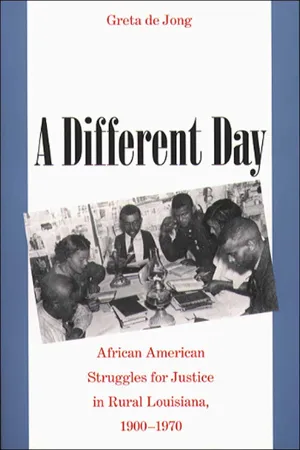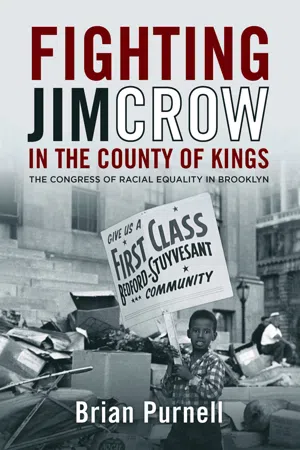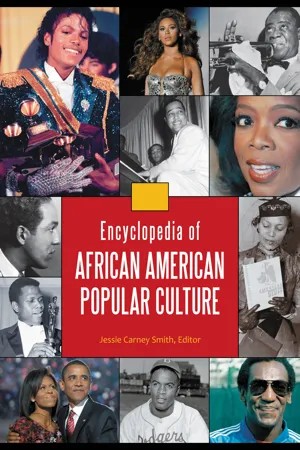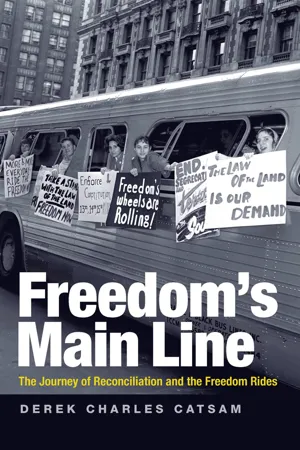History
Congress of Racial Equality
The Congress of Racial Equality (CORE) was a prominent civil rights organization in the United States, known for its nonviolent activism and advocacy for racial equality. Founded in 1942, CORE played a significant role in the American civil rights movement, organizing protests, sit-ins, and freedom rides to challenge racial segregation and discrimination.
Written by Perlego with AI-assistance
Related key terms
1 of 5
4 Key excerpts on "Congress of Racial Equality"
- eBook - ePub
A Different Day
African American Struggles for Justice in Rural Louisiana, 1900-1970
- Greta de Jong(Author)
- 2003(Publication Date)
- The University of North Carolina Press(Publisher)
8 To Provide Leadership and an Example:
The Congress of Racial Equality and Local People in the 1960sIn August 1962 CORE received a grant from the Voter Education Project to conduct voter registration drives in seven parishes in Louisiana's Sixth Congressional District, located in the southeastern part of the state. The organization's Louisiana Freedom Task Force was active in the region for the next four years, conducting intensive voter registration drives during the summer months as well as working with local leaders on more long-term community organizing projects. In the mid-1960s CORE expanded its reach to include eight additional parishes in the northern Fourth and Fifth Congressional Districts.1CORE began its work in rural Louisiana with three main objectives: increasing black voter registration, desegregating public facilities, and training local people in nonviolence. Volunteers aimed to encourage people to join the civil rights movement by educating them about the importance of voting and teaching them how to challenge segregation using nonviolent direct action. As time went on, CORE workers realized that not all of the black people they worked with shared their ideas about how best to overcome white supremacy. Voter registration provided a common goal that local people as well as outside activists embraced. But attempting to desegregate restaurants or public facilities did not seem as important to some black Louisianans as gaining fair treatment by employers, increases in pay, and access to decent jobs. Despite CORE's efforts to convert them to nonviolence, many local activists continued to carry guns to defend themselves. CORE workers eventually modified their own attitudes toward both these issues. By the mid-1960s most volunteers had accepted the practice of armed self-defense, and CORE as an organization began to emphasize economic inequality as the major problem facing African Americans. In the second half of the decade, the goals of the broader freedom struggle were revived and given new impetus by federal antipoverty programs that offered the possibility of real change. As in the 1930s, however, white political and economic leaders in rural Louisiana successfully resisted these threats to their power. At the end of the 1960s and well into the late twentieth century, the most fundamental problems of many black people remained unresolved. - eBook - ePub
Fighting Jim Crow in the County of Kings
The Congress of Racial Equality in Brooklyn
- Brian Purnell(Author)
- 2013(Publication Date)
- The University Press of Kentucky(Publisher)
2“PASS THEM BY ! SUPPORT YOUR BROTHERS AND SISTERSIN THE SOUTH !”The Origins of Brooklyn CORE We were the first to picket in the North. We were the first to call for a nationwide boycott. We were the first to enter into negotiations with the managements of the chains. —James Robinson, national director of CORE, 1960, on CORE’s support of the student sit-in movement I was impressed with the militancy of their demeanor. They were clean. They were neat. They were forceful in what they had to say. —Maurice Fredericks, speaking in 2001 about the first time he saw Brooklyn CORE members picketing Woolworth’s CORE’s Early History, 1942–1960The Congress of Racial Equality (CORE) formed in Chicago in 1942. Initially, CORE was a spin-off group of an interfaith, pacifist organization called the Fellowship of Reconciliation (FOR). In the early 1940s a handful of FOR members formed CORE as an organization committed solely to attacking racial segregation in America. Like FOR, CORE was committed to philosophies of nonviolence promoted by the Indian anticolonial nationalist and pacifist leader Gandhi. The other pillar of CORE’s principles was its strict devotion to interracial membership. CORE hoped to create an interracial, nonviolent army that would end racial segregation in America with campaigns that employed what Gandhi called satyagraha, which translates as “soul force” or “truth force.” CORE founders believed that local chapters’ public displays of interracial solidarity and disciplined use of nonviolence would transform America into a truly color-blind democratic society.1During CORE’s first five years local chapters formed in nineteen cities, but in that time six of the groups disbanded. All these chapters were outside the South, and most were located in the Midwest. CORE also created a central committee, called the National Action Council (NAC), which was headquartered in New York City. In 1947 the NAC sponsored the Journey of Reconciliation, which sent interracial teams into the South to test local compliance with the Supreme Court’s ruling in Morgan v. Virginia (1946). In Morgan the Court declared that racially segregated accommodations on interstate buses and trains and in depot waiting rooms were unconstitutional. CORE hoped the Journey of Reconciliation would bring national attention to racial segregation in the South, but other than a handful of arrests and one violent showdown in Chapel Hill, North Carolina, the campaign did not attract much notice. CORE limited the journey to the upper-South states of Virginia, North Carolina, and Kentucky, where few whites knew about the Morgan decision and local law enforcement paid the CORE activists little attention. Significantly, CORE did not repeat this strategy in 1961, when it initiated the Freedom Rides and sent those interracial teams to the Deep South, where they encountered bombings and beatings and focused the entire country’s attention on CORE’s nonviolence and the brutality of Southern segregation.2 - eBook - PDF
- Jessie Smith(Author)
- 2010(Publication Date)
- Greenwood(Publisher)
The volunteers were subjected to arrests without press coverage and without violent backlash. The campaign was short-lived. Notwithstanding the anticlimactic results of that campaign (no measures were taken to enforce the 1946 interstate law), CORE had positioned itself in the Freedom Riders 553 vanguard of civil rights activism. Established in 1942 by one black, James Farmer, and two whites, George Houser and Bernice Fisher, CORE was sup- ported in the early years by a pacifist organization called the Fellowship of Rec- onciliation. In the 1940s, CORE members staged sit-ins at restaurants and other segregated facilities. CORE sit-ins drew little media attention; however, subse- quent demonstrations, beginning with the Freedom Rides, made headlines in newspapers and on television. Demonstrations, including picketing, sit-ins, marches, as well as nonviolent civil disobedience were mainstays of the Civil Rights Movement. Rosa Parks, in 1955, would prove that her demonstration of civil disobedience, by refusing to give up her seat on public bus, was an effective method of protest. Her demon- stration and subsequent arrest sparked a monumental bus boycott, led by Martin Luther King Jr. The Montgomery Bus Boycott made nationwide news and inspired other boycotts throughout the South. In 1960, another major demon- stration was initiated by young black college students who staged a sit-in at a Woolworth’s in Greensboro, North Carolina, prompting the youth-led Sit-in Movement and the formation of SNCC. All together, these demonstrations paved the way for subsequent gains in civil rights. In 1961, Farmer became CORE’s national director, and he set out to coordi- nate the Freedom Rides. Like any grassroots activity, the Freedom Rides relied Police officers watch from a sidewalk as a Trailways bus carrying Freedom Riders arrives in Jackson, Mississippi, in the summer of 1961. - eBook - PDF
Freedom's Main Line
The Journey of Reconciliation and the Freedom Rides
- Derek Charles Catsam(Author)
- 2009(Publication Date)
- The University Press of Kentucky(Publisher)
One such organization was the Congress of Racial Equality, which had first formed in 1942. CORE was just beginning to establish itself as a new and important force in civil rights in 1947, when it decided to jointly spon- sor a “Journey of Reconciliation” with the New York–based Fellowship of Reconciliation. Bayard Rustin was one of the prime movers in getting the Journey off the ground. 22 “I Think You Are Doing a Brave and Wonderful Thing”: The Journey of Reconciliation, 1947 Houser and Rustin, who began planning the trip in late 1946, selected April 9, 1947, as the starting date for the Journey. Although the trip was intended to test existing laws and their enforcement in the face of the Mor- gan decision, ultimately its purpose was greater. Many years after the trip, George Houser outlined some of the considerations that made the idea of the Journey so appealing. Segregation on transportation in the South was an important issue, one that had to be tackled; such a campaign would draw attention, and it would have behind it the force of law. 23 Once CORE and FOR jointly decided to sponsor the trip, they developed a more sche- matic threefold purpose for the project. First, they would “gather data in a planned and scientific fashion on what is happening when Negroes and whites travel together without heed to patterns of segregation in states where Jim Crow laws prevail.” The second purpose was “to develop tech- niques for dealing creatively with possible conflict situations that will arise when segregation patterns are ignored on buses and trains.” And third, they
Index pages curate the most relevant extracts from our library of academic textbooks. They’ve been created using an in-house natural language model (NLM), each adding context and meaning to key research topics.



